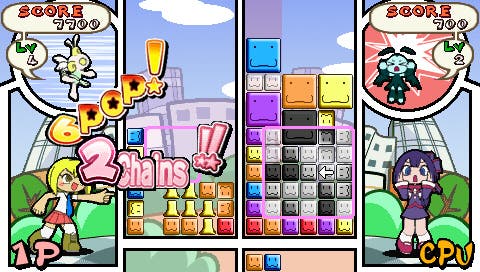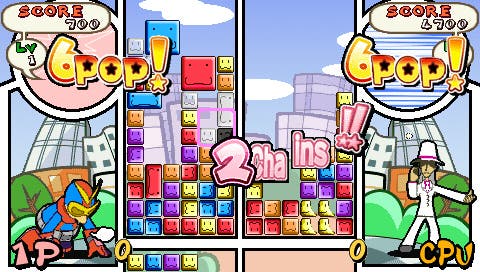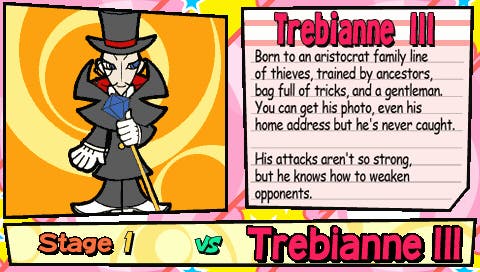Koloomn
US name Ultimate Block Party obviously a bit specious for us.
Whichever bit of the colourful manual it is that explains why "Koloomn" is called "Koloomn", when it was called "Kollon" in Japan and "Ultimate Block Party" in America, I haven't come across it.
"Kollon" I understood: that's the name of one of the silly little anime characters who dance along on the edge of the game screen, Super Puzzle Fighter II style, giving the AI opposition a face to want to smack with your fists when you lose.
"Ultimate Block Party" I understood: American publishers thirst for appalling brand names so their games can fail when they head out into tricky, well contested genres. They do this as a personal affront to those of us who actually care about them.
"Koloomn" though I've not fully looked into. And I don't really care to. This being one of those time-consuming block puzzle games - of the popular "rotation" subset - recognition is more important than sense. Lumines got by just fine, after all, even when half the people who bought it announced it to me as some sort of lavatory claymore attack.
("Ultimate Block Party" though. I've half a mind to go off and kill Alexey Pajitnov just so he can spin in his grave. Mmm, rotation.)

So, Koloomn sets you up with a Tetris-style play area, which is loaded a few lines up from the bottom with some Tetris-style arrangements of coloured blocks. Using a square-shaped, four-block cursor, the object is to rotate groups of blocks so that you have four of the same colour adjacent to one another in some way. So you could have a simple square, or you could have any Tetris-style shape - be it an L, an S, a 2, or, if you pretended they were degrees of erection, like me, then you could get a wa[DELETE DELETE DELETE. It's too early for this - Ed].
Once you've put four together, they change shape and texture slightly within their little spaces on the grid and remain, unmovable, for a few short seconds, during which time you can augment the arrangement to bank more points by grafting more of the same colour onto them from around about.
And thus you are meant to keep going for as long as possible as more rows of coloured blocks are shoved up underneath you. Cleverly, you can see one row's worth of what's coming from below, and even drag it up prematurely by hitting circle if that benefits you.
To add some spice, there's the potential to chain things together, Zoo Keeper/Lumines/etc.-style, by deleting one group of blocks so that those above it fall down and immediately arrange themselves into another group underneath. Fiddle a few of these chains together and your points total goes up even higher.

There are also a number of special blocks that you can employ. For example, an arrow on a coloured block means that if you rotate it into a group it will take all of the blocks in whichever direction it's pointing away with it.
Played in the endless single-player mode, this is all there is to it, and so you swizzle blocks merrily until the game speeds up, Tetris-style, to the point where you can no longer manage to create groups and chains quick enough to stop it spilling over the top. Game over, bank score. No Lumines-style changes of pace and undulating difficulty here - and in a sense that's a shame.
Instead the focus is on competitive modes. As well as an ad hoc two-player mode (which assumes you both own the game), Koloomn has campaign and arcade modes that pit you against the other "characters" as you play. Here, any chains or big scores wreak havoc on the other player's area, creating two or four-strong big blocks that straddle gaps and stack up quickly, changing the size of the player cursor so normal play is thoroughly impeded, restricting his or her view of the lower lines, and even draining the colour so it's impossible to work out what's going on.
It's a nice change of pace to the single-player block-twizzling, which can seem to go on endlessly without offering much in the way of surprise or excitement.

Now, Koloomn is nicely put together. The anime art style is pleasantly OTT, the music's pleasantly ARG and the puzzling's pleasantly OCD. But, unless you're patient with it, the game can be over PDQ. KWIM? The arcade/campaign modes won't require more than a couple of continues to complete quickly, with little difference between characters, and the single-player endless mode soon accelerates into the unmanageable.
Questing after high scores might keep you going for a while, with a leaderboard that you can only just clamber onto to start with, but the likelihood is that even at that you're going to find that you tire of it within a few hours. Unless, of course, you find that subtle snick on the wall that hooks you into a pattern of gradually understanding more about the manipulation and how it works best. Lumines was very good at this: though you might falter to begin with, soon you grasped the basics; though you might struggle to build for a while, soon you figured out the common patterns and how to overcome them; and so on. Koloomn is less intuitive in this respect, and lacks the audio-visual rewards, but there is a sense of it there.
If you can be bothered to go looking for it, Koloomn might be a good investment. Otherwise, particularly for those of us already mesmerised by Lumines or quite happy with our range of DS puzzlers, perhaps, it's almost too simple, and I can think of at least a handful of block puzzle games I'd rather play instead.

